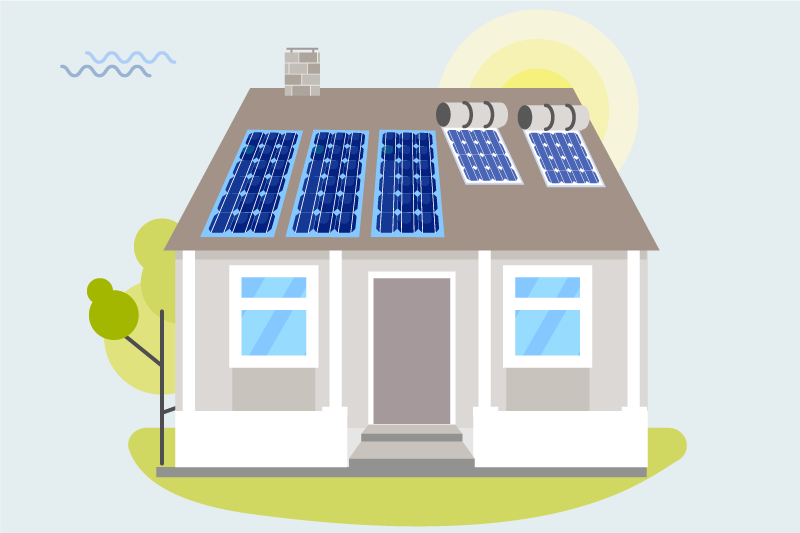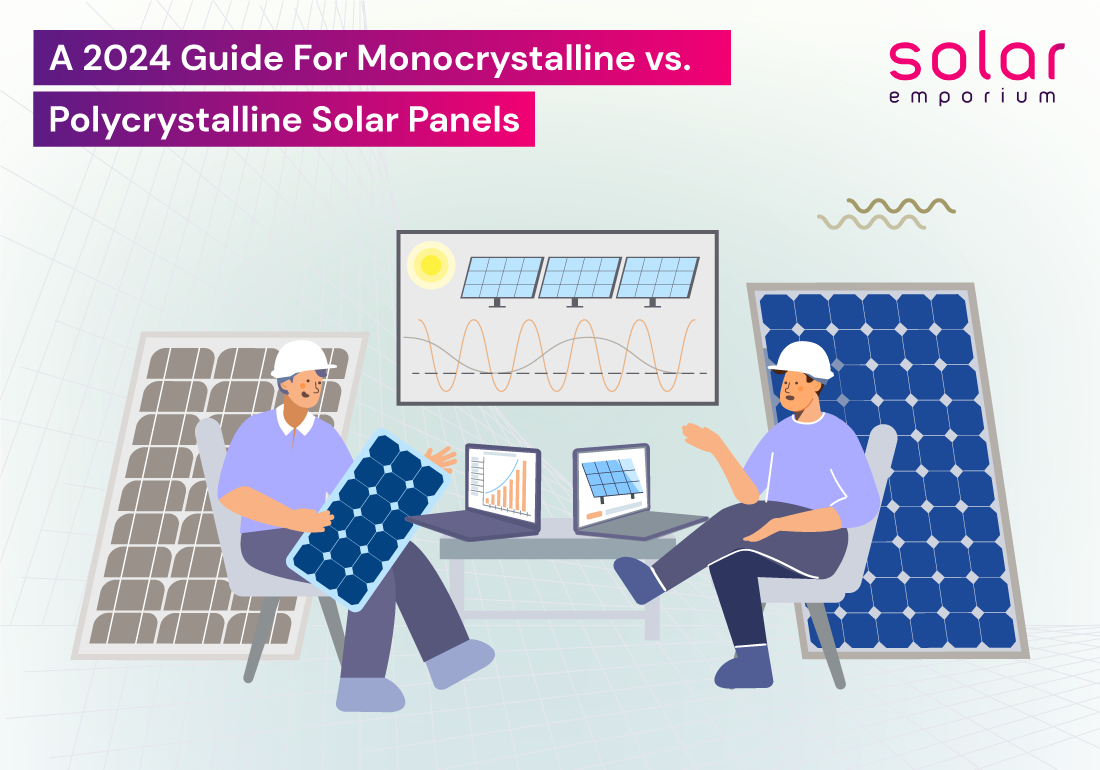All solar panels seem the same or similar. But if you take a closer look, you’ll see some minor differences, especially in the color of the solar cells. These differences are significant because they affect how much the panels cost and electricity they can make.
There are a few kinds of solar panels you can buy. They include monocrystalline, polycrystalline, and thin-film panels. And here’s A 2024 guide for Monocrystalline vs. Polycrystalline solar panels
The type of solar panels you select will influence your system’s overall performance and cost-saving potential. Top solar companies offer the most popular options: monocrystalline and polycrystalline panels.
Although both are compatible with home solar panel system, their efficiency, appearance, and long-term benefits differ.
What Are Monocrystalline and Polycrystalline Solar Panels?
Monocrystalline and polycrystalline solar panels are two types of panels that many people use in their homes.
They’re both made from pure silicon, a common material found on Earth. Silicon can turn sunlight into electricity, so it’s excellent for making solar panels.
These panels have cells that absorb sunlight and change it into usable electricity. Both monocrystalline (mono) and polycrystalline (poly) panels use silicon cells, but they’re made differently.
Monocrystalline Solar Panels
Monocrystalline panels are made using a single silicon crystal. This crystal is shaped into a cylinder called an ingot.
Manufacturers then cut these ingots into thin discs, or wafers, shaped like octagons to fit more into a panel. These wafers are turned into solar cells and put into the panel.
Because they use single crystals, monocrystalline panels efficiently make power for your home. But they cost more because the process to make them is expensive, and there’s extra silicon that can’t be reused.
Polycrystalline Solar Panels
Polycrystalline panels are made from lots of tiny silicon crystals melted together. Sometimes, these include leftover bits from making monocrystalline panels. The melted silicon is then shaped into solar cells cut into cubes.
These panels are less efficient because the silicon fragments can have flaws. But they’re cheaper because the process is simple. Factories can make more mono-panels with the leftover bits from the crystals. So, polycrystalline panels are less expensive.
Monocrystalline vs. Polycrystalline Solar Panels

Monocrystalline and polycrystalline panels differ in several ways, like cost, looks, and how well they work.
Here’s a comparison to help you understand how these differences might affect your solar panel system.
Metrics Side by Side
Average Cost
The main thing that affects how much solar panels cost is how they’re made. Monocrystalline panels are more expensive because they need unique materials and a complex process to make them.
Polycrystalline panels are cheaper because they use lower-quality materials, and some parts are reused from making monocrystalline panels. Other installation parts, like inverters and wiring, cost the same for both panels.
The type of panel you choose can also impact how long your solar panel system takes, usually around six to 10 years, to pay for itself.
Monocrystalline panels are more efficient, which means they can make more energy for your home. Since solar power is cheaper than fossil fuels, using more efficient panels can help you save money faster.
However, with polycrystalline panels, you might save less in the long run, so it could take longer to pay off.
Efficiency Rating
Another essential thing to consider is how efficient the panels are. Efficiency tells you how well the panel can turn sunlight into electricity.
For example, a panel with 15% efficiency can turn 15% of the sunlight into electricity. Polycrystalline panels are typically around 13% to 16% efficient, while monocrystalline panels can be 15% to 23% efficient.
Panel Appearance
Roof Space
How much room you have on your roof matters when picking between mono and poly panels. Mono panels are better at turning sunlight into electricity, so you need fewer to power your home. They’re a good choice if your roof is small.
But with poly panels, it’s the opposite. Because they’re less efficient, you’ll need more panels to make enough energy. So, you’ll need a prominent roof to fit all those extra panels.
Typical Life Span
Most solar panels last about 25 years, usually how long their warranty lasts. But with regular care, they can keep working even after the warranty is up. Poly panels can last 25 to 35 years, while mono panels can go up to 40 years.
However, over time, all panels lose some of their efficiency. They used to make less power than they did. This happens about 0.5% each year, according to experts. High-efficiency panels retain less power than lower-efficiency ones.
Temperature Coefficient
When it’s hot or freezing, solar panels don’t work as well. They’re tested in nice weather, but anything outside can make them less efficient.
The temperature coefficient shows how much a panel’s power drops when it’s too hot or cold. Mono panels handle extreme temperatures better because they have a low coefficient. However, poly panels do less well in hot weather because their coefficient is higher.
What Other Types of Solar Panels Are There?

Thin-film solar panels are different from the usual ones but are also gaining popularity. They use thin layers of unique materials and look flatter than regular panels. But they don’t work as well, with 8% and 14% efficiency ratings.
They also last less time, usually about 10 to 20 years. These panels are suitable for small projects, like powering a shed or garage.
Bifacial solar cells make power from both sides, making them more efficient. They could be used on roofs that can catch sunlight from above and bounce off surfaces.
Copper indium gallium selenide (CIGS) solar cells are a type of thin-film solar cell made from a mix of materials. They’re known for working well and can be used in many ways in renewable energy.
Organic solar cells are light and bendy and use organic stuff to turn sunlight into power. But they’re better at it than the regular silicon panels.
Monocrystalline or Polycrystalline? Which One is Right for You?
The type of panels you pick affects how well your solar system works, how much energy it makes, and how long it takes to pay for itself.
Monocrystalline panels cost more, but they work better and last longer, especially in extreme weather. They also look sleeker and need fewer panels on your roof.
Polycrystalline panels are cheaper but could be better at making energy and require more space on your roof. They’re also blue, which might look less friendly in your house.
It is a good idea to get quotes from a few solar companies and compare what they offer. Look at efficiency, how long the panels last, and how much they cost.
How to Choose the Right Solar Panels for You

Personal Preferences
Space Limitation
You’ll want higher-efficiency panels if you have limited space on your roof. They make more electricity in less space. This matters for things like RVs or small devices.
Spending more on mono panels might be worth it in the long run because they’ll make more power for you. But cheaper poly panels might be better if you have lots of room or put panels on the ground.
Solar Financing
How you pay for your system can also affect which panels you choose. If you go for a power purchase agreement (PPA), you pay for the power your system makes.
So, your monthly payments decide how much you save. But if you buy your system outright, getting more efficient mono panels could mean more significant savings. Check out different types of Solar financing.







